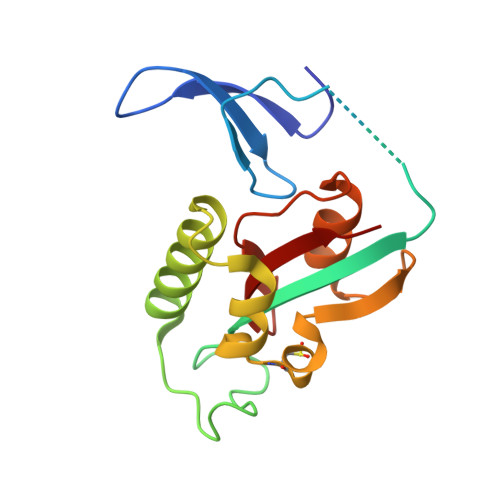Peroxide-mediated oxidation and inhibition of the peptidyl-prolyl isomerase Pin1.
Innes, B.T., Sowole, M.A., Gyenis, L., Dubinsky, M., Konermann, L., Litchfield, D.W., Brandl, C.J., Shilton, B.H.(2015) Biochim Biophys Acta 1852: 905-912
- PubMed: 25595659
- DOI: https://doi.org/10.1016/j.bbadis.2014.12.025
- Primary Citation of Related Structures:
4QIB - PubMed Abstract:
Pin1 is a phosphorylation-dependent peptidyl-prolyl isomerase that plays a critical role in mediating protein conformational changes involved in signaling processes related to cell cycle control. Pin1 has also been implicated as being neuroprotective in aging-related neurodegenerative disorders including Alzheimer's disease where Pin1 activity is diminished. Notably, recent proteomic analysis of brain samples from patients with mild cognitive impairment revealed that Pin1 is oxidized and also displays reduced activity. Since the Pin1 active site contains a functionally critical cysteine residue (Cys113) with a low predicted pK(a), we hypothesized that Cys113 is sensitive to oxidation. Consistent with this hypothesis, we observed that treatment of Pin1 with hydrogen peroxide results in a 32Da mass increase, likely resulting from the oxidation of Cys113 to sulfinic acid (Cys-SO(2)H). This modification results in loss of peptidyl-prolyl isomerase activity. Notably, Pin1 with Cys113 substituted by aspartic acid retains activity and is no longer sensitive to oxidation. Structural studies by X-ray crystallography revealed increased electron density surrounding Cys113 following hydrogen peroxide treatment. At lower concentrations of hydrogen peroxide, oxidative inhibition of Pin1 can be partially reversed by treatment with dithiothreitol, suggesting that oxidation could be a reversible modification with a regulatory role. We conclude that the loss of Pin1 activity upon oxidation results from oxidative modification of the Cys113 sulfhydryl to sulfenic (Cys-SOH) or sulfinic acid (Cys-SO(2)H). Given the involvement of Pin1 in pathological processes related to neurodegenerative diseases and to cancer, these findings could have implications for the prevention or treatment of disease.
Organizational Affiliation:
Department of Biochemistry, Schulich School of Medicine and Dentistry, The University of Western Ontario, Canada.

















